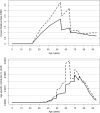Lifetime excess absolute risk for lung cancer due to exposure to radon: results of the pooled uranium miners cohort study PUMA
- PMID: 38172372
- PMCID: PMC10920468
- DOI: 10.1007/s00411-023-01049-w
Lifetime excess absolute risk for lung cancer due to exposure to radon: results of the pooled uranium miners cohort study PUMA
Abstract
The Pooled Uranium Miners Analysis (PUMA) study is the largest uranium miners cohort with 119,709 miners, 4.3 million person-years at risk and 7754 lung cancer deaths. Excess relative rate (ERR) estimates for lung cancer mortality per unit of cumulative exposure to radon progeny in working level months (WLM) based on the PUMA study have been reported. The ERR/WLM was modified by attained age, time since exposure or age at exposure, and exposure rate. This pattern was found for the full PUMA cohort and the 1960 + sub-cohort, i.e., miners hired in 1960 or later with chronic low radon exposures and exposure rates. The aim of the present paper is to calculate the lifetime excess absolute risk (LEAR) of lung cancer mortality per WLM using the PUMA risk models, as well as risk models derived in previously published smaller uranium miner studies, some of which are included in PUMA. The same methods were applied for all risk models, i.e., relative risk projection up to <95 years of age, an exposure scenario of 2 WLM per year from age 18-64 years, and baseline mortality rates representing a mixed Euro-American-Asian population. Depending upon the choice of model, the estimated LEAR per WLM are 5.38 × 10-4 or 5.57 × 10-4 in the full PUMA cohort and 7.50 × 10-4 or 7.66 × 10-4 in the PUMA 1960 + sub-cohort, respectively. The LEAR per WLM estimates derived from risk models reported for previously published uranium miners studies range from 2.5 × 10-4 to 9.2 × 10-4. PUMA strengthens knowledge on the radon-related lung cancer LEAR, a useful way to translate models for policy purposes.
Keywords: Cohort study; Lifetime risk; Lung cancer; Mortality; Radon; Uranium miners.
© 2023. The Author(s).
Conflict of interest statement
The authors have no relevant financial or non-financial interests to disclose.
Figures

Similar articles
-
Lifetime Risks for Lung Cancer due to Occupational Radon Exposure: A Systematic Analysis of Estimation Components.Radiat Res. 2025 Mar 1;203(3):175-187. doi: 10.1667/RADE-24-00060.1. Radiat Res. 2025. PMID: 39881589
-
Radon and lung cancer in the pooled uranium miners analysis (PUMA): highly exposed early miners and all miners.Occup Environ Med. 2023 Jul;80(7):385-391. doi: 10.1136/oemed-2022-108532. Epub 2023 May 10. Occup Environ Med. 2023. PMID: 37164624 Free PMC article.
-
Histopathologic Analysis of Lung Cancer Incidence Associated with Radon Exposure among Ontario Uranium Miners.Int J Environ Res Public Health. 2018 Oct 31;15(11):2413. doi: 10.3390/ijerph15112413. Int J Environ Res Public Health. 2018. PMID: 30384407 Free PMC article.
-
Risk of lung cancer from radon exposure: contribution of recently published studies of uranium miners.Ann ICRP. 2012 Oct-Dec;41(3-4):368-77. doi: 10.1016/j.icrp.2012.06.033. Epub 2012 Sep 12. Ann ICRP. 2012. PMID: 23089036 Review.
-
Health effects in underground uranium miners.Occup Med. 2001 Apr-Jun;16(2):331-44. Occup Med. 2001. PMID: 11319055 Review.
Cited by
-
Exposure to radon progeny and cancer mortality, excluding lung cancer, in the cohort of Newfoundland Fluorspar Miners between 1950 and 2016.Radiat Environ Biophys. 2025 Aug;64(3):371-378. doi: 10.1007/s00411-025-01136-0. Epub 2025 Jul 17. Radiat Environ Biophys. 2025. PMID: 40676180 Free PMC article.
-
Development of a High-Resolution Indoor Radon Map Using a New Machine Learning-Based Probabilistic Model and German Radon Survey Data.Environ Health Perspect. 2024 Sep;132(9):97009. doi: 10.1289/EHP14171. Epub 2024 Sep 18. Environ Health Perspect. 2024. PMID: 39292674 Free PMC article.
-
Advancements in lung cancer: molecular insights, innovative therapies, and future prospects.Med Oncol. 2025 Jul 28;42(9):383. doi: 10.1007/s12032-025-02725-1. Med Oncol. 2025. PMID: 40719980 Review.
-
Inverse dose protraction effects of high-LET radiation: Evidence and significance.Mutat Res Rev Mutat Res. 2025 Jan-Jun;795:108530. doi: 10.1016/j.mrrev.2025.108530. Epub 2025 Jan 14. Mutat Res Rev Mutat Res. 2025. PMID: 39818312 Review.
References
-
- ICRP The 2007 recommendations of the international commission on radiological protection. ICRP publication 103. Ann ICRP. 2007;37:2–4. - PubMed
MeSH terms
Substances
Grants and funding
LinkOut - more resources
Full Text Sources
Medical

